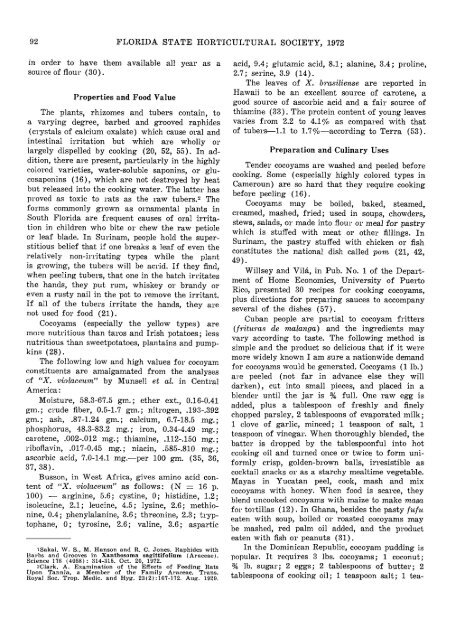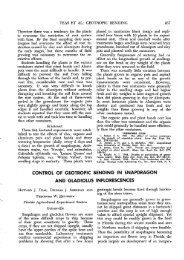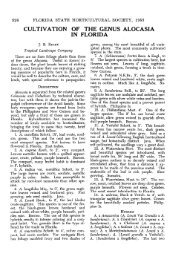(xanthosoma caracu, x. atrovirens and x. nigrum), ancient root
(xanthosoma caracu, x. atrovirens and x. nigrum), ancient root
(xanthosoma caracu, x. atrovirens and x. nigrum), ancient root
You also want an ePaper? Increase the reach of your titles
YUMPU automatically turns print PDFs into web optimized ePapers that Google loves.
92 FLORIDA STATE HORTICULTURAL SOCIETY, 1972<br />
in order to have them available all year as a<br />
source of flour (30).<br />
Properties <strong>and</strong> Food Value<br />
The plants, rhizomes <strong>and</strong> tubers contain, to<br />
a varying degree, barbed <strong>and</strong> grooved raphides<br />
(crystals of calcium oxalate) which cause oral <strong>and</strong><br />
intestinal irritation but which are wholly or<br />
largely dispelled by cooking (20, 52, 55). In ad<br />
dition, there are present, particularly in the highly<br />
colored varieties, water-soluble saponins, or glu-<br />
cosaponins (16), which are not destroyed by heat<br />
but released into the cooking water. The latter has<br />
proved as toxic to rats as the raw tubers.2 The<br />
forms commonly grown as ornamental plants in<br />
South Florida are frequent causes of oral irrita<br />
tion in children who bite or chew the raw petiole<br />
or leaf blade. In Surinam, people hold the super<br />
stitious belief that if one breaks a leaf of even the<br />
relatively non-irritating types while the plant<br />
is growing, the tubers will be acrid. If they find,<br />
when peeling tubers, that one in the batch irritates<br />
the h<strong>and</strong>s, they put rum, whiskey or br<strong>and</strong>y or<br />
even a rusty nail in the pot to remove the irritant.<br />
If all of the tubers irritate the h<strong>and</strong>s, they are<br />
not used for food (21).<br />
Cocoyams (especially the yellow types) are<br />
more nutritious than taros <strong>and</strong> Irish potatoes; less<br />
nutritious than sweetpotatoes, plantains <strong>and</strong> pump<br />
kins (28).<br />
The following low <strong>and</strong> high values for cocoyam<br />
constituents are amalgamated from the analyses<br />
of "X. violaceum" by Munsell et ah in Central<br />
America:<br />
Moisture, 58.3-67.5 gm.; ether ext., 0.16-0.41<br />
gm.; crude fiber, 0.5-1.7 gm.; nitrogen, .193-.392<br />
gm.; ash, .87-1.24 gm.; calcium, 6.7-18.5 mg.;<br />
phosphorus, 48.3-83.2 mg.; iron, 0.34-4.49 mg.;<br />
carotene, .002-.012 mg.; thiamine, .112-.150 mg.;<br />
riboflavin, .017-0.45 mg.; niacin, .585-.810 mg.;<br />
ascorbic acid, 7.0-14.1 mg.—per 100 gm. (35, 36,<br />
37,38).<br />
Busson, in West Africa, gives amino acid con<br />
tent of "X. violaceum'' as follows: (N = 16 p.<br />
100) — arginine, 5.6; cystine, 0; histidine, 1.2;<br />
isoleucine, 2.1; leucine, 4.5; lysine, 2.6; methio-<br />
nine, 0.4; phenylalanine, 3.6; threonine, 2.3; tryp-<br />
tophane, 0; tyrosine, 2.6; valine, 3.6; aspartic<br />
lSakai, W. S., M. Hanson <strong>and</strong> R. C. Jones. Raphides with<br />
liarbs <strong>and</strong> Grooves in Xanthosoma sagittifolium (Araceae).<br />
Science 178 (4058): 314-315. Oct. 20, 1972.<br />
-'Clark, A. Examination of the Effects of Feeding Rats<br />
Upon Tannia, a Member of the Family Araceae. Trans.<br />
Royal Soc. Trop. Medic, <strong>and</strong> Hygr. 23(2): 167-172. Aug\ 1929.<br />
acid, 9.4; glutamic acid, 8.1; alanine, 3.4; proline,<br />
2.7; serine, 3.9 (14).<br />
The leaves of X. brasiliense are reported in<br />
Hawaii to be an excellent source of carotene, a<br />
good source of ascorbic acid <strong>and</strong> a fair source of<br />
thiamine (33). The protein content of young leaves<br />
varies from 2.2 to 4.1% as compared with that<br />
of tubers—1.1 to 1.7%—according to Terra (53).<br />
Preparation <strong>and</strong> Culinary Uses<br />
Tender cocoyams are washed <strong>and</strong> peeled before<br />
cooking. Some (especially highly colored types in<br />
Cameroun) are so hard that they require cooking<br />
before peeling (16).<br />
Cocoyams may be boiled, baked, steamed,<br />
creamed, mashed, fried; used in soups, chowders,<br />
stews, salads, or made into flour or mea] for pastry<br />
which is stuffed with meat or other fillings. In<br />
Surinam, the pastry stuffed with chicken or fish<br />
constitutes the national dish called pom (21, 42,<br />
49).<br />
Willsey <strong>and</strong> Vila, in Pub. No. 1 of the Depart<br />
ment of Home Economics, University of Puerto<br />
Rico, presented 30 recipes for cooking cocoyams,<br />
plus directions for preparing sauces to accompany<br />
several of the dishes (57).<br />
Cuban people are partial to cocoyam fritters<br />
(frituras de malanga) <strong>and</strong> the ingredients may<br />
vary according to taste. The following method is<br />
simple <strong>and</strong> the product so delicious that if it were<br />
more widely known I am sure a nationwide dem<strong>and</strong><br />
for cocoyams would be generated. Cocoyams (1 lb.)<br />
are peeled (not far in advance else they will<br />
darken), cut into small pieces, <strong>and</strong> placed in a<br />
blender until the jar is % full. One raw egg is<br />
added, plus a tablespoon of freshly <strong>and</strong> finely<br />
chopped parsley, 2 tablespoons of evaporated milk;<br />
1 clove of garlic, minced; 1 teaspoon of salt, 1<br />
teaspoon of vinegar. When thoroughly blended, the<br />
batter is dropped by the tablespoonful into hot<br />
cooking oil <strong>and</strong> turned once or twice to form uni<br />
formly crisp, golden-brown balls, irresistible as<br />
cocktail snacks or as a starchy mealtime vegetable.<br />
Mayas in Yucatan peel, cook, mash <strong>and</strong> mix<br />
cocoyams with honey. When food is scarce, they<br />
blend uncooked cocoyams with maize to make masa<br />
for tortillas (12). In Ghana, besides the pasty fufu<br />
eaten with soup, boiled or roasted cocoyams may<br />
be mashed, red palm oil added, <strong>and</strong> the product<br />
eaten with fish or peanuts (31).<br />
In the Dominican Republic, cocoyam pudding is<br />
popular. It requires 3 lbs. cocoyams; 1 coconut;<br />
% lb. sugar; 2 eggs; 2 tablespoons of butter; 2<br />
tablespoons of cooking oil; 1 teaspoon salt; 1 tea-





